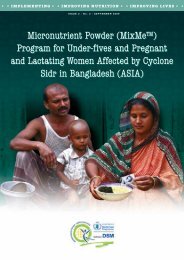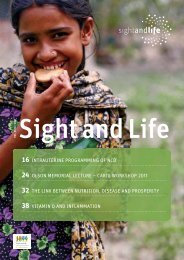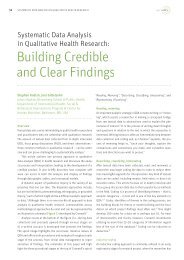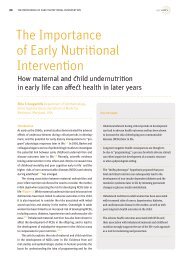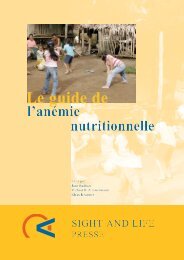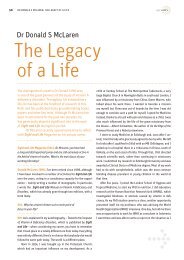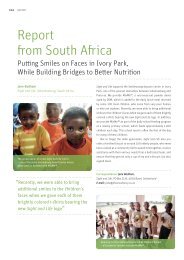Sight and Life Magazine 1/2011
Sight and Life Magazine 1/2011
Sight and Life Magazine 1/2011
You also want an ePaper? Increase the reach of your titles
YUMPU automatically turns print PDFs into web optimized ePapers that Google loves.
22 THE IMPORTANCE OF VITAMIN ADespite low plasma retinol levels, most of the women had high-carotene levels (80% >0.5 μmol/L). However, the high levelsof -carotene in plasma may be taken as a sign of low conversionto vitamin A due to the recently described BCMO polymorphism.20 As a consequence, these women are at risk of low vitaminA supply due to a very low intake of preformed vitamin A.This results in very low levels of retinol in blood <strong>and</strong> breast milkfor the newborn.There is limited data linking the intake of vitamin A duringpregnancy to cord blood levels <strong>and</strong> fetal development. Shah <strong>and</strong>co-workers demonstrated a strong relationship between lowsocio-economic status, low cord blood <strong>and</strong> low body weight ofthe newborn. 44If there is evidence that the vitamin A status of the mother ispoor, a parenteral supply (intramuscular application) is recommended.The impact on the general health of the child includinglung function is controversial, however.Prevention <strong>and</strong> therapyIn view of the importance of vitamin A, as above, the questionarises as to possible therapeutic interventions – especially forimminent premature deliveries, but also for premature infants<strong>and</strong>, in cases of poor maternal vitamin A status, for prevention ofpotential diseases <strong>and</strong> /or immaturities of the lung. Where thereis a risk of prematurity, vitamin A might be delivered antenatally,regardless of maternal vitamin A status, to ensure sufficient fetallung retinyl ester stores. Based on US Dietary Reference Intakerecommendations, daily vitamin A supplementation during anypart of the fertile period should be limited to 3,000 IU. However,a moderate dosage <strong>and</strong> a short period of supply might notbe sufficient to replete lung retinyl ester stores in cases of poormaternal vitamin A status. Higher doses during the last termof pregnancy might be more effective <strong>and</strong> pose no risk of teratogenicity,but this has not been proven to date.One solution could be the intravenous administration of vitaminA. However, with the infusion systems used so far it appearsthat vitamin A is almost completely absorbed by the polyethylenetubes <strong>and</strong> is damaged by light. 6 One way of improvingavailability consists of coating the infusion systems with foil toavoid further loss of the vitamin due to light. Since such solutionsare no longer available on the market <strong>and</strong> new parenteralvitamin A preparations are not yet available, the importance ofsupplying the mother with vitamin A before delivery needs tobe highlighted. Parenteral administration of retinyl margarinate(an unphysiological fatty acid ester of retinol) resulted in arapid increase of retinyl margarinate <strong>and</strong> further retinyl esters(as a result of hydrolysis <strong>and</strong> re-esterification) in several tissues,including the lung, in vitamin A depleted rats. 52 The results ofthis study clearly document that retinyl esters can be taken upinto different tissues circumventing the liver <strong>and</strong> the control ofdelivery via retinol-RBP. At present there are no data regardingthe risk of parenteral vitamin A supply in pregnant women witha high risk of preterm labor (e.g. those on bed rest). However,because teratogenic effects occur during the first term, adminisfigure5: Retinol <strong>and</strong> -carotene in maternal plasma, cord blood <strong>and</strong> colostrum in women who delivered twins (n=6) (A)or women with short birth intervals (n=24) (B). (Schulz et al., 2007) 507.5A***2.5B2.0Retinol [μmol/L]5.02.5*-carotene [μmol/L]1.51.00.50.0MaternalplasmaCordplasmaColostrum0.0MaternalplasmaCordplasmaColostrum*p



